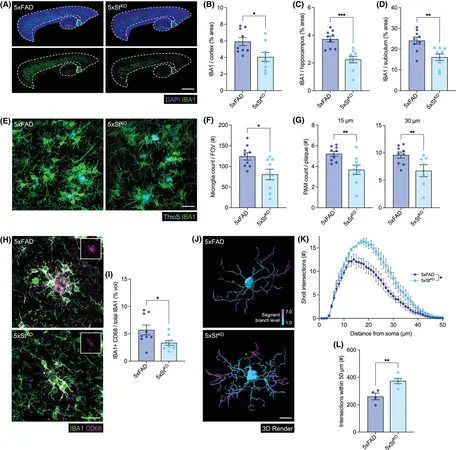
Breakthrough Discovery: How the Immune Molecule STING Could Hold the Key to Stopping Alzheimer's
2025-06-02
Author: Nur
A New Perspective on Alzheimer's Disease
In a groundbreaking approach to understanding Alzheimer's disease, scientists from the University of Virginia School of Medicine have unveiled a potentially revolutionary discovery. Their research indicates that an immune molecule known as STING plays a pivotal role in exacerbating cognitive decline associated with Alzheimer's and other neurodegenerative disorders.
The Role of STING in Alzheimer's and Beyond
Published in Alzheimer's & Dementia, the study highlights how STING drives the formation of the toxic plaques and tangles in the brain that are characteristic of Alzheimer’s disease. Researchers found that inhibiting STING in lab mice not only prevented mental decline but also shielded their brains from damage.
Moreover, STING may also be a significant player in diseases like Parkinson’s, ALS, and various forms of dementia. This discovery opens up a pathway for developing treatments that could benefit millions suffering from these life-altering conditions.
What Happens in the Aging Brain?
John Lukens, Ph.D., who leads the research at UVA’s Harrison Family Translational Research Center, explains that DNA damage naturally accumulates over time, activating STING and triggering harmful brain inflammation and neuronal damage in Alzheimer's patients. This discovery sheds light on the alarming correlation between aging and increased Alzheimer's risk, presenting an innovative target for therapeutic intervention.
The Rapidly Expanding Alzheimer's Crisis
As Alzheimer's cases soar in the U.S.—projected to rise from over 7 million to 13 million by 2050—scientists are hustling to decode its complexities. While the precise origins of the disease remain elusive, the emerging consensus underscores the critical role the immune system plays in Alzheimer's development, with STING at its center.
Innovative Research Findings
Lukens and his team observed that blocking STING dampens the activation of microglia, the immune cells responsible for clearing debris in the brain. This protection allowed nearby neurons to thrive and enhanced memory function in Alzheimer's model mice. Jessica Thanos, a key researcher in this study, affirms that STING exacerbates detrimental immune responses, further escalating neuronal damage and cognitive decline.
STING: A Beacon of Hope for Treatment
Unlike other molecules previously studied in relation to Alzheimer’s, STING presents a particularly attractive target for therapy, as inhibiting it may simultaneously reduce both amyloid plaque buildup and tau tangle formation, two leading culprits in Alzheimer’s pathology.
Thanos emphasizes the need for ongoing research to understand the intricate role of innate immune activation in the brain during both normal aging and pathological conditions. Identifying which cells and signals sustain STING activation is crucial for effective and timely interventions.
Toward Better Treatments and Cures
While this pioneering research is a significant step forward, much work lies ahead before these findings translate into safe and effective treatments. Understanding STING’s broader roles, including its implications in cancer immunity, will be critical in avoiding unforeseen side effects of potential therapies.
Lukens and his team at the Harrison Family Translational Research Center remain committed to unraveling these complexities, with hopes of accelerating the development of new treatments to mitigate neuronal damage in Alzheimer’s patients. As Lukens puts it, "Our goal is to devise safer, more effective strategies to protect the aging brain, illuminating how STING contributes to damage may help us target similar molecules for effective treatments."



 Brasil (PT)
Brasil (PT)
 Canada (EN)
Canada (EN)
 Chile (ES)
Chile (ES)
 Česko (CS)
Česko (CS)
 대한민국 (KO)
대한민국 (KO)
 España (ES)
España (ES)
 France (FR)
France (FR)
 Hong Kong (EN)
Hong Kong (EN)
 Italia (IT)
Italia (IT)
 日本 (JA)
日本 (JA)
 Magyarország (HU)
Magyarország (HU)
 Norge (NO)
Norge (NO)
 Polska (PL)
Polska (PL)
 Schweiz (DE)
Schweiz (DE)
 Singapore (EN)
Singapore (EN)
 Sverige (SV)
Sverige (SV)
 Suomi (FI)
Suomi (FI)
 Türkiye (TR)
Türkiye (TR)
 الإمارات العربية المتحدة (AR)
الإمارات العربية المتحدة (AR)